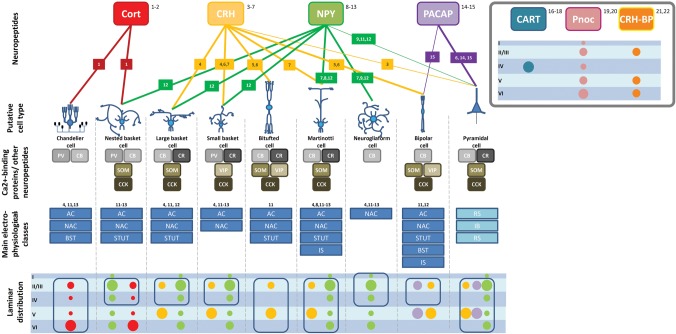Figure 3.
Scheme summarizing the laminar distribution and the main molecular, anatomical, and electrophysiological properties of the various neuronal types in which the EE-up-regulated neuropeptides are expressed. On top are the differentially regulated neuropeptides. The lines indicate in which cell type the peptides can be found: (thick line) common, (thin line) rare. Next, calcium-binding proteins ([PV] parvalbumin, [CB] calbindin, [CR] calretinin) and other neuropeptides which can be co-expressed with the EE-regulated neuropeptides are indicated, followed by the main electrophysiological classes corresponding to the putative cell type ([AC] accommodating, [NAC] nonaccommodating, [BST] bursting [STUT] stuttering, [IS] irregular spiking, [RS] regular spiking, [IB] intrinsic burst spiking). Finally, the colored circles indicate in which cortical layer the corresponding neuropeptide is expressed (laminar distribution), the size of the circles being proportional to the amount of expression; a blue rectangle defines the layers where the putative cell type can be found. There is insufficient information on putative cell type, electrophysiological classes, and additional molecular markers for the neuropeptides/neuropeptide-binding protein Cart, Pnoc and Crhbp. The information has been summarized on the basis of several studies; each study where the specific information has been derived from is indicated by a number, and the list of numbers with corresponding references, details of the study, and hyperlinks can be found in Supplemental Table 2.

